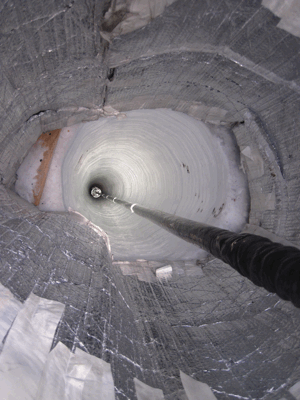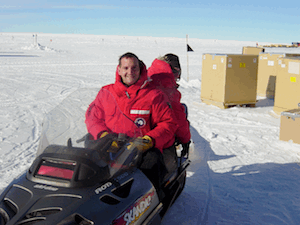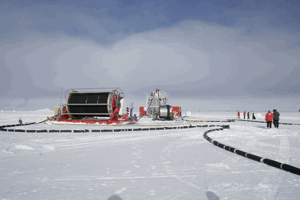The Search for Neutrinos in the Antarctic
Air Date: Week of January 28, 2011

A sensor descends down a hole in the ice as part of the final season of IceCube. (NSF/B. Gudbjartsson)
In the South Pole, scientists are building an unusual telescope one and a half miles deep down into solid ice. Their goal is to track common, subatomic particles called neutrinos and, as IEEE Spectrum’s Glenn Zorpette reports, the hard-to-detect neutrinos could give the scientists clues about some of the biggest mysteries of the universe.
Transcript
CURWOOD: In the IEEE Spectrum's documentary Antarctica: Life on the Ice, scientists search for neutrinos. These tiny, tiny, sub-atomic particles streak across the universe -- they're among the most common things that exist — yet also among the most difficult to detect. In a unique effort to see neutrinos, engineers are now turning a cubic kilometer of ice under the South Pole into one of the oddest telescopes in the world.
By spotting some of the countless neutrinos that pass through matter, this telescope is expected to help scientists understand cosmic mysteries such as black holes, exploding stars, and dark matter. Glenn Zorpette visited Antarctica and took a look.

A sensor descends down a hole in the ice as part of the final season of IceCube. (NSF/B. Gudbjartsson)
[PUMP-ROOM SOUND]
ZORPETTE: How do you make a hole two and a half kilometers down into solid ice? You melt your way down. It takes two days and 20 000 gallons of hot water. Dennis Duling showed me how it’s done.
DULING: That’s our drill water for this project.
ZORPETTE: So you actually use hot water to drill?
DULING: Yes we do.
ZORPETTE: There’s no metal bit. Just hot water.

Drilling manager Dennis Duling. (NSF/J. Haugen)
DULING: We use 200 gallons a minute at 90 C, which is boiling in the environment. And we push it out at 1,000 pounds of pressure out of a three-quarter-inch nozzle. That equates up to the power of a Burlington locomotive, a big one at full power, coming out of that nozzle. That’s why this drill will drill what it drills.
[PUMP-ROOM SOUND]
ZORPETTE: Duling is the drill manager for the company building the IceCube observatory. So far, he’s drilled 79 of these mile-and-a-half holes in a kilometer-square stretch of ice near the South Pole. He has seven more to go.
[MACHINERY RUNNING]
ZORPETTE: Once a hole is drilled, technicians lower into it a string of 60 basketball-sized light detectors. By February of 2011, over 5,000 detectors will lie frozen in a billion tons of ice. They’re going to look for the most elusive particles in the universe: neutrinos.

Physicist Mark Krasberg (NSF/Hagar Landsman)
KRASBERG: Neutrinos are really neat—they’re chargeless, they’re almost massless. You’ve actually got 10 million going through your thumb every second. They’re really, really hard to detect.
ZORPETTE: Mark Krasberg is a physicist on the
IceCube project. He explains that because neutrinos don’t interact with anything, they’re very hard to detect. But that same lack of interaction also means they can zip across vast stretches of the universe unimpeded. So to astronomers, neutrinos are like minuscule messengers carrying news about exploding stars, baby black holes, and other violent events that occurred unimaginably far away, and an unimaginably long time ago.

The drill shack for the Ice Cube project is the square near the center of the image. The hose carries superheated and super-pressurized water that drills holes one and a half miles deep in the ice, near the South Pole. Light detectors placed in the holes will sense very faint, blue Cherenkov radiation, given off by muons, created by neutrinos moving through the ice. (Photo: Glenn Zorpette)
KRASBERG: Since neutrinos are chargeless, they go on a straight line through the universe. You basically, if you have a source, just have a straight line going back, and you can ask an astronomer, "what’s at that spot in the sky"?
ZORPETTE: Neutrinos can also come from sources closer to home. In fact, neutrinos coming from the center of our Sun or our Milky Way galaxy could give physicists clues about the nature of dark matter, the mystery mass that pervades our universe but about which nothing is known. But how do you detect particles that are almost undetectable? Well, the IceCube telescope is looking for the one-in-a-million neutrino that crashes into an atom of an ice molecule and creates another particle called a muon. As that muon shoots through the ice, it gives off blue light. In the pure, incredibly clear ice of the South Pole, that tiny bit of light can travel hundreds of feet. And then it can hit those basketball-size light detectors.
KRASBERG: It’s basically an inverse lightbulb. It collects the light and converts it into charge. There’s a computer on top of here and the signals go to the surface.
ZORPETTE: Researchers hope these ghostly particles will help them solve some of the biggest mysteries of the universe. And, if they do, then one day this strange telescope under the ice might not seem so strange after all.
CURWOOD: Our story, by IEEE Spectrum's Glenn Zorpette, is from the documentary Antarctica: Life on the Ice.
Links
Living on Earth wants to hear from you!
Living on Earth
62 Calef Highway, Suite 212
Lee, NH 03861
Telephone: 617-287-4121
E-mail: comments@loe.org
Newsletter [Click here]
Donate to Living on Earth!
Living on Earth is an independent media program and relies entirely on contributions from listeners and institutions supporting public service. Please donate now to preserve an independent environmental voice.
NewsletterLiving on Earth offers a weekly delivery of the show's rundown to your mailbox. Sign up for our newsletter today!
 Sailors For The Sea: Be the change you want to sea.
Sailors For The Sea: Be the change you want to sea.
 The Grantham Foundation for the Protection of the Environment: Committed to protecting and improving the health of the global environment.
The Grantham Foundation for the Protection of the Environment: Committed to protecting and improving the health of the global environment.
 Contribute to Living on Earth and receive, as our gift to you, an archival print of one of Mark Seth Lender's extraordinary wildlife photographs. Follow the link to see Mark's current collection of photographs.
Contribute to Living on Earth and receive, as our gift to you, an archival print of one of Mark Seth Lender's extraordinary wildlife photographs. Follow the link to see Mark's current collection of photographs.
 Buy a signed copy of Mark Seth Lender's book Smeagull the Seagull & support Living on Earth
Buy a signed copy of Mark Seth Lender's book Smeagull the Seagull & support Living on Earth

